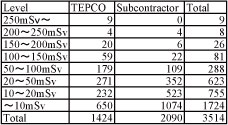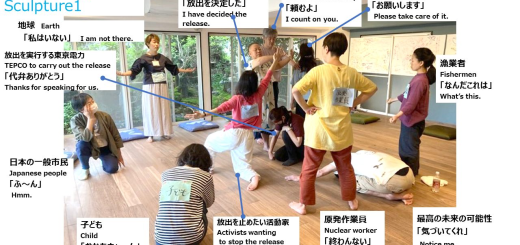Lax radiation dose calculations continue at Fukushima Nuclear Power Station Nuke Info Tokyo No. 143
CNIC and other groups hold joint negotiations with government on plant worker exposure
At Fukushima Daiichi Nuclear Power Station, workers are being forced to undertake dangerous work while being exposed to high levels of radiation. The plant operator Tokyo Electric Power Co. (TEPCO) continues to be lax with radiation dose calculations, and the mass media are reporting almost daily cases of plant workers exposed to extremely high levels of radiation.
On June 20, TEPCO announced that a total of nine plant workers are known to have been exposed to radiation higher than the legal limit of 250 mSv. (See Table 1)
| Table 1: Evaluated external and internal exposure levels of emergency workers who started work at Fukushima Daiichi Nuclear Power Plant up to the end of March (Preliminary values) |
 |
| (Based on TEPCO report of June 20) |
On March 15, four days after the accident at Fukushima Daiichi, the Ministry of Health, Labor and Welfare (MHLW) revised its ministerial ordinance and raised the maximum exposure limit for workers engaged in emergency operations at the plant from 100 mSv to 250 mSv.
On April 28, the ministry issued an administrative notification 0428-1 entitled ‘Guidance concerning exposure rates for workers engaged in emergency work when they carry out non-emergency work following the emergency work’ to the heads of all regional labor departments. In this notice, the ministry said it will not issue a guidance to the worker even if he exceeds the annual radiation exposure limit of 50 mSv, but will direct him not to exceed the “100 mSv in five years” limit. This is taken as an easing of ministerial action against worker radiation exposure.
On May 2, the Citizens’ Nuclear Information Center (CNIC) submitted to the government a request that the government protect the health and safety of both the workers exposed to radiation at Fukushima Daiichi nuclear power plant and local residents, and compensate for damage to their health. CNIC submitted this request jointly with six other groups tackling the problems facing the plant workers.
On May 16 and June 17, CNIC negotiated with the government jointly with the Japan Occupational Safety and Health Resource Center (JOSHRC) and Campaign Against Radiation Exposure (CARE).
On June 21, CNIC and the six other groups that submitted the request on May 2 engaged in negotiations with the government and held a meeting between the citizens concerned and lawmakers in the Diet building. The citizens participating in the meeting included Koshiro Ishimaru and Tatsuhiko Sato representing the citizens’ league in Futaba Town, Fukushima Prefecture, opposing the Fukushima Nuclear Power Station, and Takumi Aizawa from Iitate Village, Fukushima Prefecture.
In the May 16 negotiations, it was revealed that no officials from the Labor Standard Inspection Office (LSIO) have been dispatched to the Fukushima Daiichi Nuclear Power Station since the outbreak of the crisis at the plant in March, except when cabinet ministers visited the plant. According to the ministry, the officials summoned the plant operator to the ministry office whenever necessary in order to avoid exposure to radiation.
At the plant, however, many workers are being forced to work without receiving any of the necessary radiation-related education in advance, and are eating and smoking in the highly contaminated environment. This clearly indicates that there is a need for LSIO officials to visit the plant and inspect the working conditions there. On May 27, LSIO officials finally went to the plant to carry out the inspection.
On March 24, three workers from a TEPCO subcontractor company were exposed to radiation as high as 180 mSv. Why did LSIO not go to the plant and conduct an on-the-spot inspection at that time?
It was later revealed that a female worker was also exposed to a level of radiation in excess of the official limit of a total of 5 mSv over three months, which is stipulated in the Labor Safety and Sanitation Law. We were stunned by the ministry’s excessively slow response.
On June 7, the ministry reportedly conducted an on-the-spot inspection to check the working conditions at the plant before determining whether there were problems with TEPCO’s and its partner company Kandenko’s handling of radiation dose management. As a result, on June 10 the ministry ordered TEPCO to correct practices regarding its failure to prevent the plant workers from being exposed to excessive amounts of radiation in violation of the Labor Safety and Sanitation Law.
In the negotiations on June 17, the Ministry of Economy, Trade and Industry explained why it decided to lift the 50 mSv annual radiation exposure limit on the workers participating in emergency operations at Fukushima nuclear power plant and who intend to go on working at other nuclear power plants. According to the Ministry, TEPCO had demanded the elimination of the limit because it had estimated that the total number of workers who would probably exceed the 50 mSv limit and become unable to work at other plants at around 1600, which would mean that other nuclear power plants may face labor shortages.
Furthermore, it has been revealed that thousands of workers are currently working under very severe conditions in the radiation-controlled areas, but that only one medical doctor is stationed there. Immediately after the accident, there were occasions when no doctor was present. However, since May 14, when a worker died of a cardiac infarction while delivering drainage machinery and materials, a doctor has been stationed in the plant twenty-four hours a day. It is obvious that only one doctor is insufficient for this large number of workers. With the searing summer heat coming on, proper measures need to be taken promptly.
CNIC and other groups have demanded that the government provide them with a list of TEPCO subcontractor companies to which the workers belong. The government, however, stated that it does not know which workers belong to which company. Although MHLW ordered TEPCO to conduct, before the end of June, whole body counter examinations on about 3,700 workers who took part in emergency operations in March, TEPCO is still unable to identify around 30 of the workers.
On June 27, the head of the Industrial Safety and Health Department of MHLW’s Labour Standards Bureau summoned medical experts to the ministry to hold discussions on long-term health management of the workers at the Fukushima Daiichi nuclear power plant.
This was the first meeting of its kind and the main objective of the meeting was to discuss how to provide long-term health management, including post-retirement management, for the workers engaged in emergency operations. There are concerns that in the future the workers may have health problems resulting from their exposure to radiation, and the participants of the meeting discussed various issues, such as the types of data that should be included in the database.
In view of this situation, it is necessary for the public to closely monitor the plant workers’ exposure to radiation.
Mikiko Watanabe (CNIC)
A list of the requests for protecting the health and safety of nuclear power plant workers and local residents, and for compensating for damage to their health, which was included in CNIC’s written request submitted to the government on May 2. This list was presented during the negotiations with the government and in the meeting held between the citizens and lawmakers concerned in the Diet on June 21.
- Promptly repeal the 250 mSv radiation exposure limit for the plant workers engaged in emergency operations,
- Guarantee non-radiation-related jobs for TEPCO’s sub-contractors and affiliated companies’ workers who were exposed to radiation exceeding the maximum permissible exposure level in ordinary conditions while engaged in emergency operations. Such jobs should be offered not only to the plant workers who are exposed to a total of 100 mSv or higher in five years, but also to those who absorb a total of 50 mSv or higher in one year,
- Determine the total number of plant workers engaged in emergency operations not carrying a dosimeter, and accurately evaluate their external and internal exposure levels, record their readings in the radiation dosage management notebook, and notify them of the results immediately. In addition, strictly manage the radiation dose calculations of not only the plant workers exposed to radiation, but also all other workers as well,
- Provide all nuclear power plant workers with health-record books immediately, and manage the condition of their health appropriately. Moreover, provide various types of health management for those who have worked in Fukushima Daiichi plant, including mental care,
- Improve the existing extremely poor working environment for the workers dealing with the problems arising from the accident at the nuclear power plant,
- Repeal the maximum allowable radiation exposure level for children at 20 mSv/year (3.8 Sv/hour outdoors) stipulated in the “Provisional concept for determining the usability of school buildings and playgrounds in Fukushima Prefecture,” and radically lower the limit in consideration of the maximum allowable exposure level for the public. The central government should carry out the removal (or purification) of contaminated topsoil from Fukushima school grounds and take responsibility for this work,
- The government should provide the victims of the accident at the Fukushima Nuclear Power Station with a health-record book and take responsibility for management of their health. It should compensate victims for health damage caused by the accident.
Futaba Anti-Nuclear Energy Alliance, Japan Congress Against A- and H-Bombs, Ibaraki Anti-Nuclear Collective, No Nukes Hiroshima, Citizens’ Nuclear Information Center, Campaign Against Radiation Exposure (CARE)


